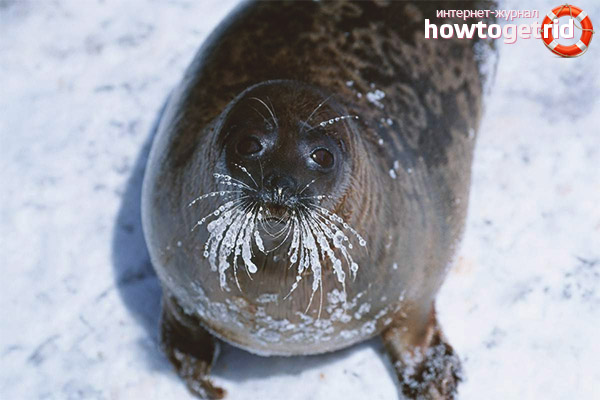The content of the article
The ringed seal resembles in its structure a small seal, whose weight is about 50 kg. The body looks short with a dense layer of fat. A small head is located on a squat neck. The skin is covered with a hard, slightly noticeable pile. Adult males and females have a different color - from black to tan. All over the body, except for flippers, light rings are scattered.
Distribution area
These representatives of mammals are found mainly in the Arctic and subarctic zones of the Atlantic and Pacific oceans. They prefer to live in northern waters and belong to those inhabitants of the planet who feel comfortable only in cold and snowy regions.
Seals can be seen in any corner of the northern part of Russia, on the Murmansk coast, near the Novosibirsk islands or the White Sea. The exceptions are the central part of the Barents Sea, where seals do not appear, since there is no ice cover in this area.
Inhabitants of the Far East coast call ringed seals akiba. Individuals begin to migrate from the western regions of the Coastal Sea, after which they move to the territory of the Commander and Aleutian islands, populating the water area around the coast. In the Sea of Okhotsk, real settlements are arranged.
In addition to the seas of the Eurasian continent, nerves are considered the coast of Norway and Greenland, the Canadian Arctic archipelago and the Hudson's Bay. The animal spends most of its life in water, which is its source of nutrition.
Ringed seals have practically no tendency to migrate. Only the inhabitants of the eastern coast of the Barents Sea with the arrival of summer heat move to the neighboring water basin of the Kara Sea, and at the end of the season they return. Some individuals remain on drifting ice, which the current carries to the open sea. However, seals manage to even find a place where they lived in summer or autumn from a remote distance. Migration is typical only for groups of mammals inhabiting the regions of the Sea of Okhotsk and the Baltic.
Diet
The Baltic Sea is a source of food rich in sprats, gobies, cod and herring, and the saline waters of the Coastal Sea are in the Arctic. With the advent of autumn, Akibs often manage to eat navaga or herring, gerbils and gobies are rarely found. The spring ration of the seal consists of such invertebrates as mysids, black-eyed and amphipods.
Breeding seals
Seals begin to bring offspring in mid-March or April. Meetings of females and males for mating occur, as a rule, in the same period - April or May. A pregnant female carries a calf for approximately 11 months. Small seals are born, wrapped in a protein coat, subsiding after a few weeks. Their weight does not exceed 4 kg, and their body length is 84 cm. The female feeds offspring with milk for one month. This time is enough for the calf to grow and grow well. Year-old seals weigh 14 kg. At the age of 7 years, young individuals weigh approximately 34 kg.
Achieving puberty in females is observed at the age of 5-6 years. Each year, the average number of offspring ranges from 20-40%. Maturity of males occurs a year later than that of females.In adult seals that are approaching the age of ten, growth stops.
Habits

Breeding of seals occurs on the ice in the coastal region, but the inhabitants of the Sea of Okhotsk have adapted to the survival of drifting ice and are capable of breeding offspring even under such conditions.
The vast territory of thick immovable ice surfaces allows animals to be housed individually, without forming clusters. Each individual has the opportunity to leave the pack and choose any site for hunting and rookery. Drifting snow pads collect hundreds of seals in one place. For access to the open sea, animals use lasers, through which they stick their heads and fill the lungs with oxygen. Near the hole, females make lairs hidden from prying eyes in order to give birth to future small seals in this snowy shelter.
Number of individuals in the northern hemisphere
Ringed seal is one of the most common mammal species found on the northern coasts. According to the latest data, their number is approaching 5 million individuals. The bulk of the animals inhabits the Arctic. About one fifth of the total number of this subspecies is located in the coastal waters of the Canadian Arctic Archipelago. In the Sea of Okhotsk, there are no more than 800 thousand animals, and the rest are dispersed in the coastal zones of the Eurasian continent.
Fishing and value of ringed seal
Commercial value is the skin, meat and seal fat. Thanks to the fishing of these mammals, subsistence farming is developing that supports the population of the coastal regions of the north. Crafts of pinnipeds in the Soviet years laid the foundation for the formation of the national economy.
Video: ringed seal (Phoca hispida)










Submit